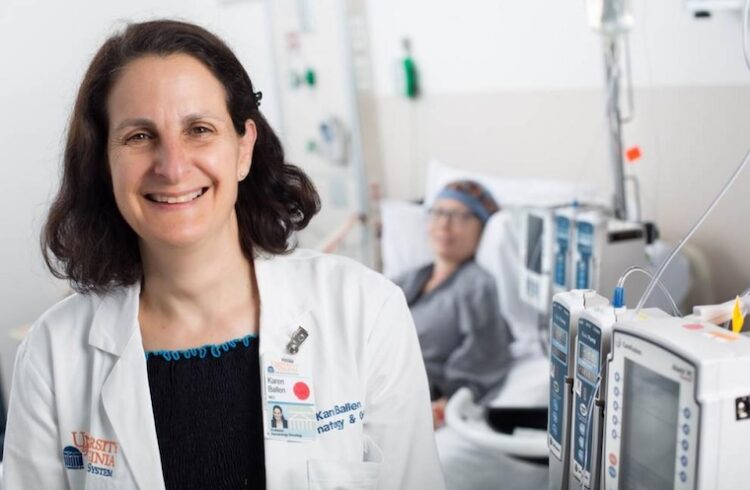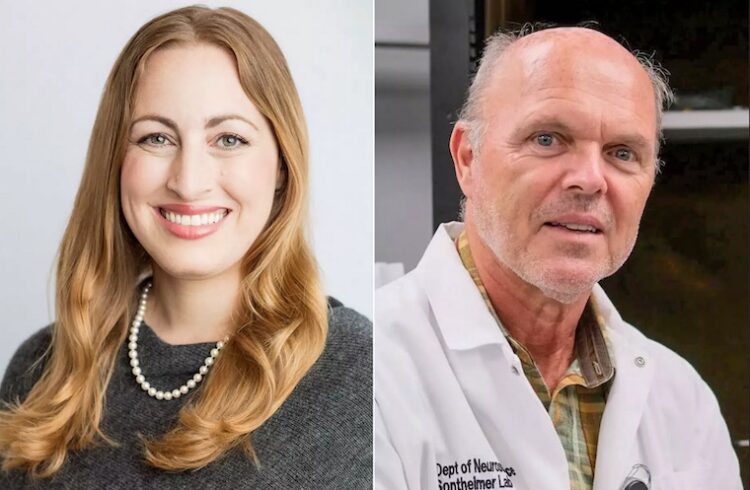
Dr. Nina Solenski, a neurologist in the Primary Stroke Center at the University of Virginia Health System, has been busy learning to drive. Instead of a car, she’s learning how to maneuver a robot over a wireless network using her laptop and a control stick. The robot, known as the Remote Presence Robotic System (RP-7), will be used at UVA and its partner site – 25-bed Bath Community Hospital in Hot Springs – to assess and talk to patients and their doctors from afar.
An associate professor of neurology, Dr. Solenski is UVA’s Project Officer for the newly launched Virginia Acute Stroke Tele-Health Network (VAST) initiative. VAST is testing the effectiveness of RP-7s in helping experts, like Dr. Solenski, assess stroke patients without being on-site with them.
The RP-7 is five-feet, six-inches tall and has a flat panel head and camera lens eyes. As the robot moves about and does its work, the face of the person at its controls is projected on its flat panel display. “The robot’s camera and speakers function as my eyes and ears,” notes Dr. Solenski. “It’s on rollers, so I can sit at my laptop and drive it to a patient’s bedside. Within minutes after stroke patients arrive in the ER, I can start helping on-site doctors evaluate and treat them. The RP-7 also lets me speak with patients and zoom-in to check their condition myself.”
Dr. Solenski uses the control stick to steer the RP-7 down hallways. “People are surprised to see a robot traveling around by itself. It can go just about anywhere, but we’ve discovered it needs help taking elevators,” she notes. In those cases, an escort accompanies the robot as it moves from place to place.
Funded by a $1.3M grant from the National Office of Rural Health Policy, VAST is a quality improvement initiative aimed at integrating stroke systems of care across Virginia. The program is testing a variety of health information technologies to see if they give rural, critical access hospitals quicker and improved access to stroke experts at the regional hospitals and other health care providers that support them.
Implementation of VAST is being made possible by a partnership of the Virginia Department of Health, the Virginia Stroke System Task Force and the Virginia Telehealth Network. Its goal is to decrease Virginia’s stroke mortality rates – which are among the nation’s highest – and boost the number of stroke patients who receive the clot-buster, t-PA. The drug saves lives if administered within three hours after stroke symptoms start. However, in 2006, only two percent of patients in Virginia received it.
“Everyone agrees that Virginians in rural areas need better access to the kind of acute stroke care and expertise we provide at UVA 24-hours a day, seven days a week,” says Dr. Karen C. Johnston, Chair of UVA’s Department of Neurology. “Our stroke team is excited about the VAST initiative and the opportunity to collaborate with colleagues at Bath Community and other hospitals around the state. We expect that the new technologies deployed by VAST will improve our ability to work together and share our expertise to ensure that all Virginians receive the best possible stroke care.”
Advanced Technologies Are Key To Improving Stroke Outcomes
According to Cynthia Barrigan, Project Manager of VAST and Executive Director of the Virginia Telehealth Network, Bath Community is also installing a Picture Archiving and Communications System and enhanced radiology capabilities. These technologies will enable its staff to rapidly transfer CT scans for reading, interpretation and reporting by UVA experts. Bath Community will soon have the capability to exchange x-rays and other images with the two other regional hospitals participating in the VAST pilot – Rockingham Memorial in Harrisonburg and Augusta Medical Center in Fishersville.
“VAST’s overarching goal is to reduce the time to expert care for stroke patients in rural communities,” says Barrigan. “When rural, critical care hospitals – like Bath Community – have round the clock access to expertise and resources at larger hospitals, their patients will receive faster, more effective treatment. We believe that equipping rural hospitals with new technologies is essential to improving our state’s stroke outcomes.”
Evaluation of the RP-7s at both hospitals will conclude next February. At UVA, the robot’s effectiveness will be directly compared with results achieved by on-site stroke experts. If the robots prove successful, RP-7s may help deliver state-of-the-art care at other rural, critical care hospitals around the state.
Looking to the future, Dr. Karen Rheuban, Medical Director of UVA’s Office of Telemedicine says, “VAST will open the door to contemporary life-saving stroke therapies for more Virginians. We anticipate expanding this effort to many of the 60 sites in UVA’s telehealth network.”
Related links:
RP-7 Robot: http://www.intouchhealth.com/products_rp7robot.html
Virginia Telehealth Network: http://ehealthvirginia.org/
UVA Department of Neurology: http://www.healthsystem.virginia.edu/internet/neurology/
UVA Office of Telemedicine network map: http://www.healthsystem.virginia.edu/internet/telemedicine/images/newmap.jpg


